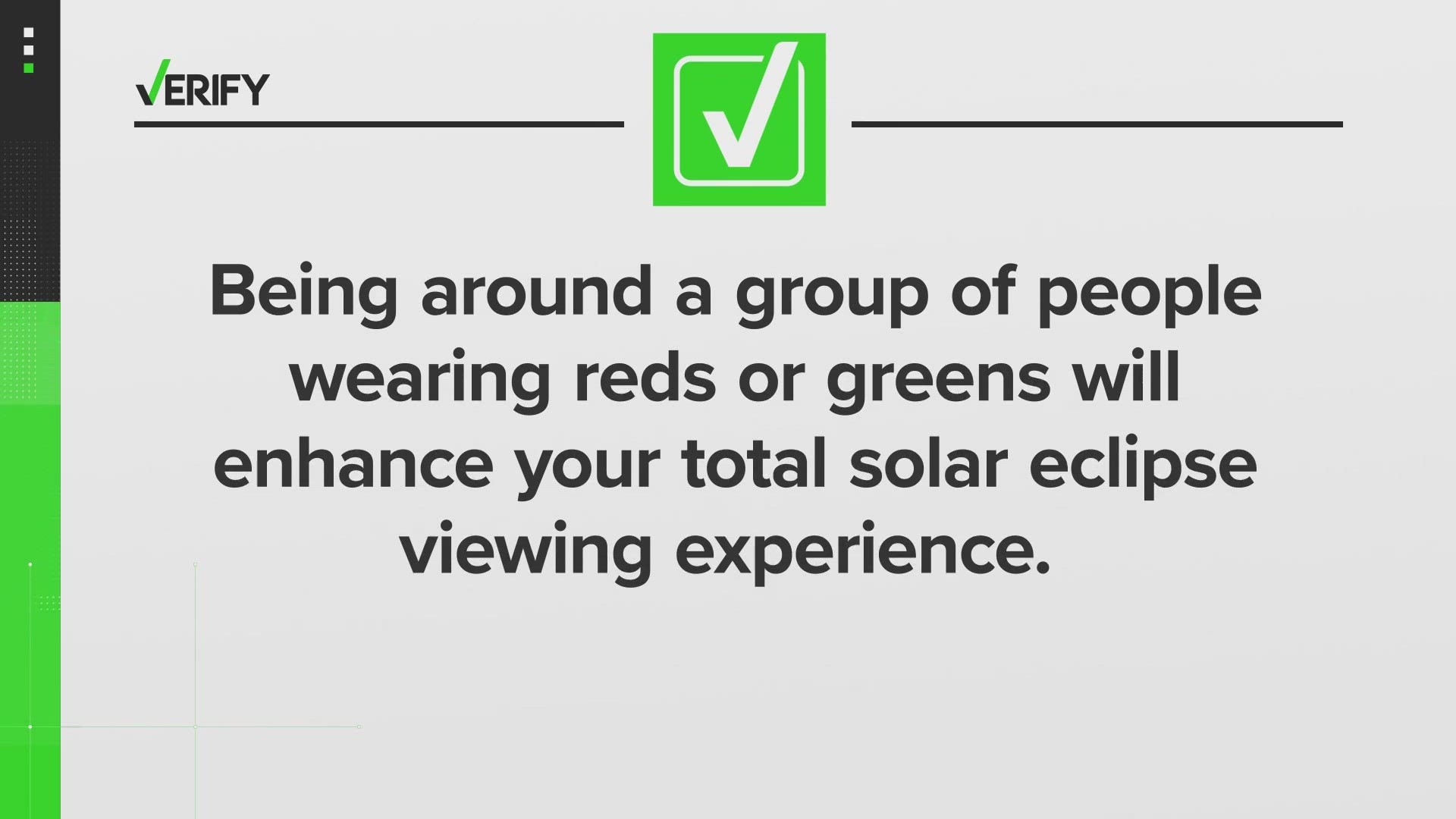CLEVELAND — Northeast Ohio is lucky enough to be in the path of totality for the solar eclipse happening on April 8.
THE CLAIM
With the event just five weeks away, the people behind the eclipse glasses company Solar Eyeglasses are making this claim: "If you're going to watch the eclipse in person, being around a group of people wearing reds or greens will enhance your viewing experience."
THE SOURCES
To VERIFY if this is true, we talked walked with following people:
- Cleveland Clinic Cole Eye Institute ophthalmologist Dr. Nicole Bajic
- NASA volunteer educator and eclipse chaser Gordon Telepun
THE RESEARCH
Gordon Telepun has been chasing eclipses for 20 years. In 2017, he was named a subject matter expert on eclipses by NASA, and he's a member of the 2024 NASA Astronomical Society of the Pacific Eclipse Ambassador program.
He has firsthand experienced with what's known as the Purkinje effect, a phenomenon named for the Czech physiologist who first described it.
"Eclipse chasers always talk about this short period of time before second contact when totality is going happen," Telepun explained. "Second contact is when the moon completely obscures the sun.
"A lot of people will talk about it as putting on very light grey sunglasses where everything in your surroundings have a silvery metallic kind of color to them. You don't always see it at every eclipse; I saw it very strongly in the 2017 eclipse. It was wonderful. It was mysterious and eerie and almost frightening, in a way, because it's lighting that you can never see in any other circumstance.
"When I compared my pictures from 2017 — which was an August eclipse in Tennessee on a green field with people wearing summer clothes and very multi-colored umbrellas around — I realized you need to have color target to see this effect because this effect is biologic."
As Telepun describes it, the Purkinje effect is most apparent during the short period of time before the moon completely obscures the sun during a total solar eclipse. Cleveland Clinic Cole Eye Institute ophthalmologist Dr. Nicole Bajic explains the science behind this timing.
"We've got these specialized cells inside the eye called photo receptors, and that's what helps transmit light energy to what we can see," Bajic said. "And so we have the rods and cones, and rods are responsible for nighttime vision and the cones are responsible for color. Now, typically, we have something called dark adaptation that occurs as we transition to nighttime, and it takes about 20 to 30 minutes. It allows the rods — the nighttime vision cells — to take over so that we can see during nighttime conditions.
"Now what's interesting during the eclipse is we have this happening from light to dark very quickly. With less photons available, that's the light energy — the cones can't work as well, so the reds could look darker or even black, and then the blues and greens can really pop. So you'll see an eerie transition where those other colors can pop and be very bright because the cells are highly sensitized, and there's not a lot of energy but not enough for the reds, so you'll see that interesting contrast between the colors."
THE ANSWER
So we can VERIFY the claim that being around a group of people wearing reds or greens will enhance your total solar eclipse viewing experience is true.
ADDITIONAL INFORMATION
Gordon Telepun has created his own Solar Eclipse Timer app to help people make sure they don't miss the Purkinje effect and other key moments while viewing a total solar eclipse. He's also written a book called "Eclipse Day - 2024 and More! How to enjoy, observe, and photograph a total solar eclipse," which is available for purchase here.
If you have a claim or question you'd like verified, please email it to verify@wkyc.com or text it to (216) 344-3300.

